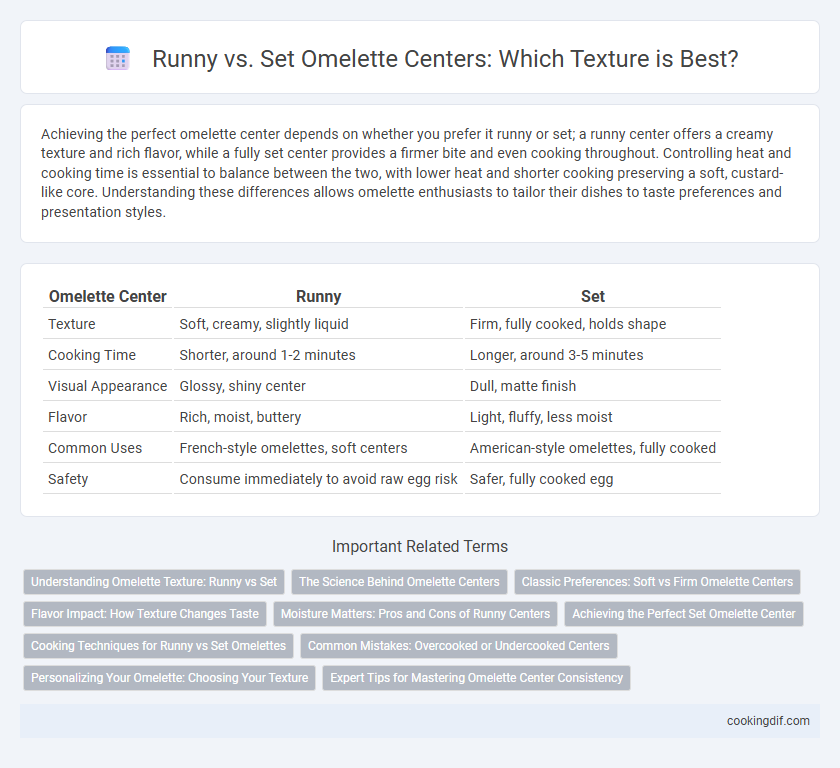Achieving the perfect omelette center depends on whether you prefer it runny or set; a runny center offers a creamy texture and rich flavor, while a fully set center provides a firmer bite and even cooking throughout. Controlling heat and cooking time is essential to balance between the two, with lower heat and shorter cooking preserving a soft, custard-like core. Understanding these differences allows omelette enthusiasts to tailor their dishes to taste preferences and presentation styles.
Table of Comparison
| Omelette Center | Runny | Set |
|---|---|---|
| Texture | Soft, creamy, slightly liquid | Firm, fully cooked, holds shape |
| Cooking Time | Shorter, around 1-2 minutes | Longer, around 3-5 minutes |
| Visual Appearance | Glossy, shiny center | Dull, matte finish |
| Flavor | Rich, moist, buttery | Light, fluffy, less moist |
| Common Uses | French-style omelettes, soft centers | American-style omelettes, fully cooked |
| Safety | Consume immediately to avoid raw egg risk | Safer, fully cooked egg |
Understanding Omelette Texture: Runny vs Set
Omelette texture varies significantly between runny and set centers, affecting taste and mouthfeel. A runny center offers creaminess and moistness, often achieved by gently cooking eggs until partially solidified, while a set center delivers firmness and a more uniform structure through thorough cooking. Mastering heat control and cooking time is essential for tailoring omelette texture to personal preference and desired culinary outcomes.
The Science Behind Omelette Centers
The science behind omelette centers reveals that the texture depends on protein coagulation and heat application. A runny center occurs when eggs are cooked gently at low temperatures, allowing the proteins to partially set while retaining moisture. In contrast, a fully set center results from higher heat or longer cooking, causing complete protein denaturation and a firmer, drier texture.
Classic Preferences: Soft vs Firm Omelette Centers
A classic omelette's center texture significantly influences its appeal, with soft centers offering a creamy, tender bite ideal for rich fillings like cheese or herbs, while firm centers provide a more cohesive structure preferred for heartier ingredients such as vegetables or meats. Culinary traditions often favor soft-centered omelettes for their delicate mouthfeel and moisture retention, enhancing flavor blending, whereas firm centers ensure ease of folding and presentation, maintaining shape without compromising taste. Choosing between runny and set centers depends on personal preference and the desired consistency, balancing texture with cooking technique to achieve the perfect classic omelette.
Flavor Impact: How Texture Changes Taste
A runny omelette center offers a rich, creamy texture that enhances the egg's natural buttery flavor, creating a smooth mouthfeel that balances well with savory fillings. In contrast, a set omelette center provides a firmer texture, intensifying the egg's umami notes and allowing the flavors of added ingredients like cheese or herbs to stand out more distinctly. Texture significantly influences taste perception, with the runny center delivering a luscious, melt-in-the-mouth experience while the set center offers a satisfying bite and pronounced flavor contrast.
Moisture Matters: Pros and Cons of Runny Centers
Runny omelette centers retain more moisture, resulting in a creamy texture that enhances flavor and mouthfeel, ideal for those who prefer a rich, custard-like experience. Set centers, while drier, provide a firmer structure that holds fillings better and reduces the risk of undercooked eggs, making them safer for sensitive eaters. Balancing moisture in an omelette requires precise heat control to achieve desired doneness without compromising taste or texture.
Achieving the Perfect Set Omelette Center
Achieving the perfect set omelette center requires precise control over heat and timing to ensure a tender but fully cooked interior. Cooking the eggs over medium-low heat allows the proteins to coagulate slowly, preventing rubberiness while maintaining a moist texture. Monitoring the omelette's consistency closely enables a firm yet delicate center, avoiding runniness without overcooking.
Cooking Techniques for Runny vs Set Omelettes
Cooking techniques for runny versus set omelettes hinge on heat management and timing; runny centers require gentle, low heat cooking with minimal stirring to retain a creamy texture, while set omelettes demand higher heat and thorough folding to achieve firm, fully cooked interiors. Precise control of temperature prevents overcooking, with runny omelettes often finished off with residual heat, whereas set versions benefit from continuous heat application until the eggs solidify. Mastery of these methods ensures optimal texture preferences, balancing delicate creaminess against firm structure in omelette preparation.
Common Mistakes: Overcooked or Undercooked Centers
Overcooked omelette centers become rubbery and dry, losing the creamy texture that defines a perfect omelette. Undercooked centers are often raw or overly runny, which can result in an unappetizing and potentially unsafe dish. Achieving the ideal balance requires precise temperature control and timing to create a tender, slightly custardy center without compromising food safety.
Personalizing Your Omelette: Choosing Your Texture
Personalizing your omelette involves selecting the ideal center texture, whether a runny, soft yolk or a fully set, firm interior. A runny center offers a creamy, decadent experience that enhances the flavors of fillings like cheese and herbs, while a set center provides a structured bite, perfect for added ingredients like vegetables and meats. Understanding your texture preference allows you to customize cooking time and heat to achieve the perfect balance between flavor and consistency.
Expert Tips for Mastering Omelette Center Consistency
Achieving the perfect omelette center involves balancing heat and timing to either preserve a runny texture or create a fully set finish. Experts recommend gently cooking over medium-low heat and removing the omelette just before it fully solidifies to maintain a creamy, custard-like center. For a fully set center, continue cooking until the eggs firm up evenly without browning, ensuring a tender, uniform texture throughout.
Runny vs set for omelette center Infographic

 cookingdif.com
cookingdif.com